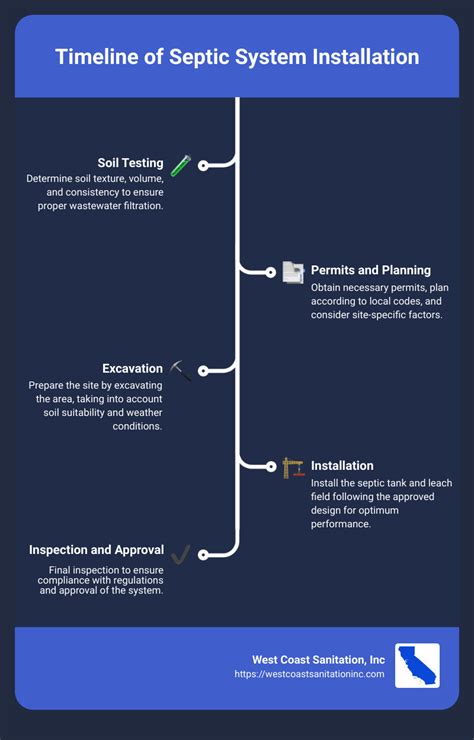Septic Install: A Quick Guide to the Timeline
Installing a septic system is a significant undertaking, impacting both your budget and daily life. Understanding the timeline involved is crucial for planning and managing expectations. This guide breaks down the septic installation process, providing a realistic timeframe for each stage. While specific timelines can vary based on factors like location, soil conditions, and permit approvals, this overview will offer a helpful benchmark.
Phase 1: Planning and Permitting (2-6 weeks)
This initial phase lays the groundwork for the entire project. It's critical to get this right to avoid delays later on.
What Happens During This Phase?
- Site Assessment: A professional will evaluate your property to determine the best location for the septic system, considering factors like soil type, drainage, and proximity to water sources. This often involves soil testing.
- System Design: Based on the site assessment, a septic system design will be created, specifying the size and type of septic tank and leach field needed. This needs to meet local regulations.
- Permit Application: The detailed design is submitted to your local health department or building authority for review and approval. This process can take time, depending on the backlog and efficiency of your local authority. Expect potential revisions and follow-up.
How Long Does it Take?
The permitting process is the most variable factor. In some areas, it can be completed within 2 weeks; in others, it might take up to 6 weeks or even longer. The site assessment and design usually take 1-2 weeks.
Phase 2: Excavation and Installation (1-3 weeks)
Once permits are approved, the actual installation begins.
What Happens During This Phase?
- Excavation: Heavy machinery will excavate the trenches for the septic tank and leach field. The depth and size of these trenches will depend on the system design.
- Septic Tank Placement: The septic tank is carefully positioned and leveled in its designated area.
- Leach Field Construction: Perforated pipes are installed within the trenches, surrounded by gravel or other approved materials to allow for efficient wastewater filtration.
- Backfilling and Grading: Once everything is in place, the trenches are backfilled and the ground is graded to its original contour.
How Long Does it Take?
This phase typically takes 1-3 weeks, depending on the size and complexity of the system and weather conditions. Unexpected challenges like rocky soil or unforeseen underground obstacles can cause delays.
Phase 3: Inspection and Finalization (1-2 weeks)
This phase ensures the system meets all regulatory requirements.
What Happens During This Phase?
- System Inspection: A licensed inspector will thoroughly examine the installed septic system to verify compliance with local codes and regulations. Corrections may be required if deficiencies are found.
- Final Grading and Landscaping: Once the inspection is passed, the final grading and landscaping are completed to restore the site to its original condition. This may involve seeding or planting grass.
- System Testing (if required): Some areas mandate a final system testing to ensure proper functionality.
How Long Does it Take?
This phase usually takes 1-2 weeks, including scheduling the inspection, addressing any necessary corrections, and completing final landscaping work.
How Long Does a Septic Installation Take in Total?
Considering all three phases, the total installation time can range from 4 to 12 weeks, or even longer under less-than-ideal circumstances. It's essential to communicate with your contractor throughout the process to stay informed of the progress and any potential delays.
What Factors Can Affect the Timeline?
- Soil Conditions: Rocky or clay-rich soils can significantly slow down excavation.
- Weather: Rain or extreme temperatures can disrupt work schedules.
- Permitting Delays: Backlogs at your local permitting office can extend the overall timeline.
- Contractor Availability: Popular contractors may have longer lead times before they can start your project.
- Unexpected Issues: Unforeseen problems, like hitting underground utilities, can add considerable time to the project.
By understanding the potential timeline and the factors that can influence it, you'll be better prepared for the septic installation process. Remember to always work with a licensed and reputable contractor to ensure a smooth and efficient installation.

